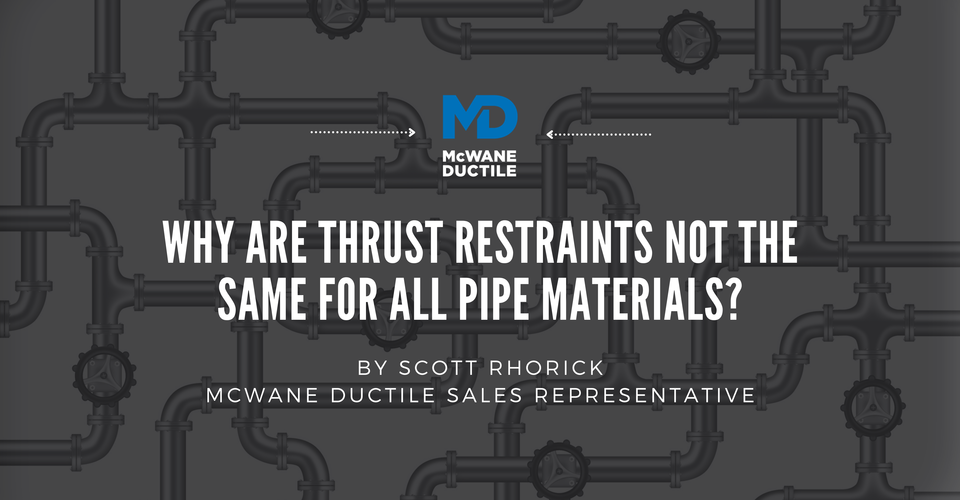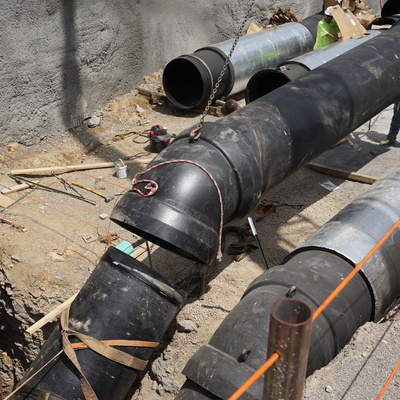In today’s marketplace, everything is in constant flux. Projects have specific completion times, and material lead times are continually increasing. For a variety of reasons, materials that typically were in stock for immediate shipment now take weeks to months before they are available to ship. You may be considering changing the piping material to be used in your water line project to another type of material. A significant consideration is how each type of piping material requires different lengths of restraint to control the change of direction in the line.
The American Water Works Association (AWWA) has design manuals for Water Supply Practices for each type of material. Each of these manuals covers the design process to determine the required length of restraint for the pipe material being used. Some pipe materials have published design guidelines and calculations for determining thrust restraint lengths, while others require the manufacturer to calculate the thrust restraint amount. Below is a list of AWWA Design Manuals:
Concrete Pressure Pipe
To determine the restraint length for Concrete Pressure pipe, you first need to know which type of concrete pipe you are using; Prestressed Concrete Cylinder Pipe (C301); Reinforced Concrete Cylinder Pipe (C300); and Concrete Bar-Wrapped Cylinder Pipe (C303). You can find the design guidelines and formulas for thrust restraint in the M9 Design Manual on pages 121-171. The pipe manufacture suggests a designer contact them to determine the required restraint lengths. There are no published thrust restraint calculators available to perform these calculations. Check out this Iron Strong blog by my colleague Clinton Fowler on Ductile Iron Pipe versus Concrete Pipe.
Steel Water Pipe
You can find the design guidelines for thrust restraint lengths for Steel Water pipe in the M11 design manual. The required design formula can be found on page 191 of the M11 design manual. The pipe manufacturer suggests the project designer contact them to determine the required lengths. There are no computer programs or website information available to perform these calculations. There are no published thrust restraint calculators available to perform these calculations. See this Iron Strong blog by my colleague Jerry Regula for more on Ductile Iron Pipe versus Steel Pipe.
PVC Pipe
The design guidelines for PVC pipe can be found in the AWWA M23 design manual on pages 42-52. The design requirements and formulas for thrust restraint lengths will vary depending upon the type of bend. There are published thrust restraint calculator programs that have been designed to calculate these lengths for you. See the Iron Strong video/blog feature The Advantages of Ductile Iron Pipe over PVC.
Ductile Iron Pipe
Ductile Iron pipe thrust restraint design requirements will depend upon the type of bend being used. The design guidelines can be found in the AWWA M41 design manual on pages 85-147. There are published thrust restraint calculators that can calculate the required thrust restraint lengths of the pipeline. McWane Ductile and the Ductile Iron Pipe Research Association (DIPRA) both have thrust restraint calculators on their websites based upon the latest version of the AWWA design manual.
Thrust Restraint Example
Let's consider an example to highlight differences in required pipe restraint lengths. This example design parameters are as follows:
| Thrust Restraint Example 16" PVC DR18 vs 16" Poly-wrapped Ductile-iron pipe | |||||||||
| Parameters of Example | |||||||||
| Line Pressure | 100 psi | ||||||||
| Test Pressure | 150 psi | ||||||||
| Soil Type | Clay-like, Sand/Clay mixture | ||||||||
| Safety Factor | 1.5 | ||||||||
| Trench Type | 5 | ||||||||
| Depth of Cover | 5 ft | ||||||||
| Soil Weight | 110 pcf | ||||||||
| Bend Type | Direction | PVC DR18 | Ductile | Direction | PVC DR18 | Ductile | Direction | PVC DR18 | Ductile |
| 90 | Horizontal | 27 | 28 | ||||||
| 45 | Horizontal | 11 | 12 | Vertical Down | 43 | 56 | Vertical Up | 7 | 7 |
| 22.5 | Horizontal | 6 | 6 | Vertical Down | 21 | 27 | Vertical Up | 4 | 4 |
| 11.25 | Horizontal | 3 | 3 | Vertical Down | 11 | 14 | Vertical Up | 2 | 2 |
| Dead End/Valve | Horizontal | 86 | 135 | ||||||
Let the Pocket Engineer Do the Math for You
So, now you have been shown an example of restraint calculation, but why not allow the calculations to be done for you? Do this by using McWane’s Pocket Engineer Calculator. Along with formulating Thrust Restraint, this handy downloadable desktop and mobile app can also figure Pipe Thickness Design, Energy Savings, Hydrotest Allowances, Flow Rates, Head Loss, and more. Check it out at pe.mcwane.com.
Summary
The required restrained lengths from the above example may not seem significant at first glance but consider a project with several valves and vertical offsets. The differences between Ductile iron pipe would add up quickly. The restraint lengths will become even greater as the size of the pipe increases. Also, remember if project drawings do include the restraint required for another material like Concrete or Steel pipe, do not assume that Ductile iron pipe will be the same. When evaluating the type of pipe material to be used on a project, please remember that Ductile iron pipe has a straightforward and reliable AWWA design manual that a designer can feel confident about.
Need Assistance with Your Waterworks Project?
If you have any questions regarding your water or wastewater infrastructure project, be sure to reach out to your local McWane Ductile representative. We have team members who've managed small and large water utility systems, served in engineering consulting firms, and bring decades of experience in solving field issues involving pipeline construction and operation. From design to submittal, to installation, we strive to provide education and assistance to water professionals throughout the water and wastewater industry.









